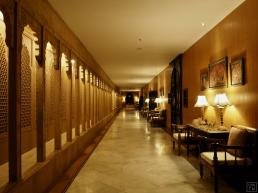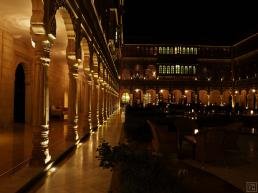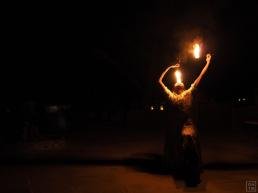Spell-bound by my previous trips to Jaipur, I decide to take a trip to a different part of Rajasthan. I return mesmerised after a five day holiday to Jaisalmer. One that included jaw dropping architecture, a blanket of stars and a trip to the border with Pakistan.

I’ve always been in awe of Rajasthan. I guess part of that has to do with my roots. Even though I was brought up in Bombay, I’m originally from Jaipur. I’ve been making trips to Jaipur for the last 25 years, and every single time I’ve been there, I’ve come across something that has blown my mind away. Rajasthan is special – there is much to see – some places that are widely known of and some others that are more obscure. Then there’s the culture and the food. It’s different – rich, colourful, warm, happy.
I’ve always wanted to see more of Rajasthan. So I decided to drive across the state and visit Jaisalmer.

So there I was. 11 am on a cool winter morning in Jaipur. Ready and packed up to leave for Jaisalmer. There’re 2 routes you can take to Jaisalmer, one via Ajmer and Jodhpur, the other via Bikaner. To choose between them was easy. I’d driven on the Ajmer highway in the past, and quite enjoyed my drive then. Who wouldn’t? The Ajmer highway is a well paved six lane highway that allows for quick progress.
My weapon of choice for this drive was a car I love dearly, the Mini Cooper Diesel. More specifically, the 5-door version. I’d driven the 3-door in Mahabaleshwar a year back and absolutely loved it. It was fast, comfortable and it handled well – just what you need on a 1500km journey.
The drive from Jaipur to Jaisalmer is a mixed bag. The road is silky smooth till about 30km past Jodhpur. Beyond that, the road is being widened and varies between being smooth and kind of being non-existent. What this means is that, the last 250km of the journey take about 5 hours. That’s a lot when you consider that the first 350km of the journey took 4 hours.

I finally reached Jaisalmer at about 8pm. The town was deserted. I saw an army officer, and ask him for directions to Suryagarh – the hotel I was going to be staying at. After another 20 minutes of driving, I arrived at what would be my abode for the next 2 days.
Suryagarh is a fort hotel that was constructed only about 5 years ago. What it loses in heritage, it makes up for with its atmosphere, charm, hospitality and great food. For starters, the hotel looks absolutely stunning. It’s about 15km outside of Jaisalmer, perched on top of a hill. You can see it from about 2km away, its yellow sand stone ramparts attracting your attention. It presents itself like an oasis, in the middle of nowhere. Seventy two lavish rooms complemented by a grand entrance, a beautiful, royal lobby area, three restaurants, a swimming pool, an organic garden, an award-winning spa and a mini-lake. But places are made by people, and the hotel staff at Suryagarh is extremely hospitable and friendly. Jaisalmer is mesmerising, and Suryagarh is an experience in itself. I’d definitely recommend staying at Suryagarh while you’re in Jaisalmer. If not, do visit the place for a meal – the makke ki roti, dal tadka and sarson ka saag present local flavours at their very best.
After a 9 hour drive, I was tired. Dinner done, I retired for the day. The next day, I got up to a sunny morning. No matter what time of the year you’re in Jaisalmer, sunny means it’ll be hot, varying degrees of hot, but hot nonetheless. Fortunately, it was still early in the day, and so, I decided to have breakfast in Suryagarh’s open air garden. A few minutes later, I was joined by a peacock. It turns out the hotel has a mini zoo in its backyard, and the peacock has been bred there since it was a baby. I’ve never been this close to a peacock before. They’re shy animals, but this one walked over and drank water from the cup I’d offered to it. I consider myself lucky to have witnessed the deep blue of a peacock’s skin from this close. They’re magical creatures, and are local to Rajasthan.

“
I was joined by a peacock at the breakfast table at Suryagarh. Peacocks are native to Rajasthan. They’re shy animals. But this one seemed comfortable trotting around the place, often getting very close to hotel guests having breakfast.
“
What was a good start to the day got even better when I visited Patwon ki Haveli. The Patwa Haveli was the first Haveli to be constructed in Jaisalmer. It’s actually a group of 5 havelis made by Guman Chand Patwa (a local trader) for his 5 sons. This is the largest haveli in Jaisalmer and stands in a narrow lane. Currently, the haveli is owned by the government. I have to admit that it is a jaw-droppingly beautiful structure. Every wall, railing, door and jharokha has a depiction carved out in yellow sand stone. Intricate patterns all carved by hand over a period of 50 years. It isn’t so much a building, but a piece of art. Pity that it hasn’t been maintained very well. The part that is currently owned by the government reeks and is bat infested. It looks like a scene from Scooby Doo.
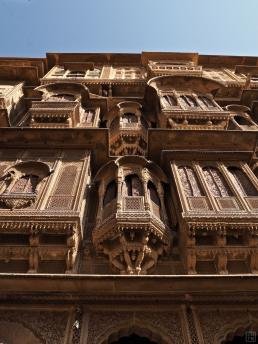
“
The Patwa Haveli isn’t so much a structure. It’s more a piece of art. I wish it had been better maintained.
“
If you want to see the haveli in all its glory, I’d suggest buying a ticket to the section that is privately managed. The ticket is marginally more expensive than the one for the area managed by the government.
After I got done with the Patwa Haveli, I decided to soak in the place and walked till the Jaisalmer fort, Jaisalmer’s primary tourist attraction. It’s when you walk through the narrow lanes of Jaisalmer do you realise how life there is so different from the one we’re used to living in Bombay, or for that matter, even in Jaipur. The entire economy runs on tourism. Life is simpler, people are nice and helpful and greet you with a smile. Single storied structures, at most a couple of stories high, the houses are primarily made of sand stone, a type of rock widely available in the region, and one that keeps the insides cool – important when summer temperatures scale the 50 degree celsius mark.

The Jaisalmer fort, once the crown jewel of the city (still the most popular tourist attraction), hasn’t been maintained very well. After a bad experience at the Patwa Haveli, I was in no mood to step into an enclosed space that reeked of damp air and bat droppings. So I took a few photos of the fort from the outside. As you can see in the photos, it’s quite an imposing structure.
It was approaching sun set as I walked towards Gadi Sagar Lake. At one point of time, this artificial reservoir made by the first ruler of Jaisalmer was the only source of water to the town. Sand stone chhatris, shrines, arch ways and ghats surround the Gadi Sagar lake. It’s a sight to behold when the sun’s going down, the colours of dusk reflecting off the still waters of the lake.
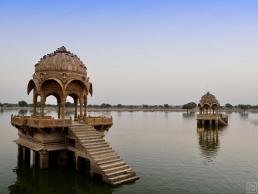
The next afternoon, I checked out from Suryagarh and took the Mini for a spin. I drove past Sam sand dunes towards the border with Pakistan. I was curious to figure out how close I could get to the border before an army contingent stopped my car and asked me to turn back. My question was answered at an Indian Army check post after an hour long drive, about 10km before the border. Small villages exist beyond this check post, up until about 5km before the border. People living in those villages have special permission to access their houses. Civilians aren’t allowed beyond this point.

The drive to the border and back was absolutely wonderful. One road, straight as an arrow, cut through the Thar desert. The Thar isn’t what you think of when you think of a desert. Unlike the Sahara, it isn’t an endless sea of sand dunes. It’s arid, yes. But there’s quite a bit of vegetation and life around. It’s more friendly, more approachable. it’s beautiful in a very stark kind of way.

In the evening, I checked into Damodra Desert Camp – a luxury camping experience set in the desert about 30km away from Jaisalmer. Appearing like a golden mirage in the charming romance of the Thar desert, the Damodra desert camp has nine well furnished Swiss style tents that offer every creature comfort you’d need, and then some more. It’s not lavish the way Suryagarh is, but it’s a more homely, more friendly setup – with owners Prithvi and Kristin personally attending to your stay and sharing some amazing stories of how they built this place from the ground up.
In one of our conversations, Kristin tells me about the patch of land barely 30m away from the camp site. The land is used for farming. Kristin calls it magic dirt. “We plow the land and plant the seeds and never water it, and yet, the crops grow fine every year. It’s all organic produce. I couldn’t believe it till I saw it. The land looks arid, but there’s quite a lot you can do with it if you’re clever and use it effectively”.
I’d have never thought of my food grains coming from a place like Jaisalmer. Clearly, there’s much more to this place than the eye can see or mind can perceive.
But the real show enfolds once the lights go out. After a sumptuous meal, you had the option of going and relaxing on top of the out house to enjoy a view of the stars, and what a view it was! A million stars to look up at, with shooting stars streaking past now and then.It was like sitting under a sea of stars. Tea, coffee and a blanket to keep you warm were bonus!
I’ve wanted to capture a north pointing star trail for the longest time. Jaisalmer provided me with the perfect canvas to do the same. The results were fantastic, as you can see in the photo. Those red dots are windmills, and the white lines under them are trails from moving cars.
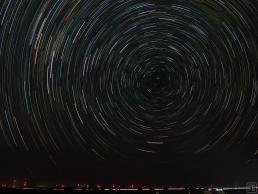
Talking about windmills. I actually drove up to one the following day. That’s when I realised how huge they are. They’re massive and intimidating structures. Making the Mini look pretty mini.
Later that afternoon, Prithvi arranged for a camel ride that took me to a relatively untouched patch of sand dunes a few kilometres away. Another reason why you should stay at Damodra. You see, most tourists go to Sam for the dune experience. That’s converted Sam into a commercial nuisance. The sand dunes are crowded, and dirty. This patch Prithvi took us to was clean and tidy and provided an unobstructed view of the sun setting over the dunes. It was my last evening in Jaisalmer, and a magical one at that.
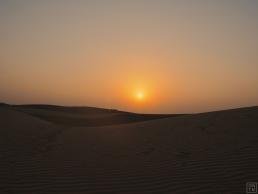
The following day I drove back to Jaipur. After spending 5 days on the road, I must say I left Jaisalmer with a huge smile on my face. The exquisite havelis, royal fort, majestic sand dunes and blanket of stars are all reasons why Jaisalmer should be on your bucket list for the year. It introduces you to a very different Rajasthan. One you don’t get to see in Jaipur. And like every other part of Rajasthan, it leaves you mesmerised and in awe.
